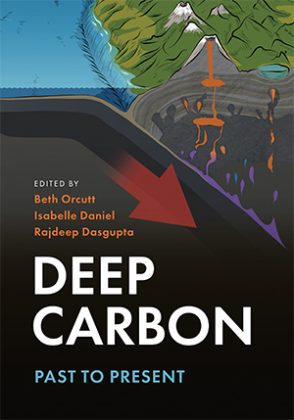Deep Carbon – a decade of DCO Research
From diamonds to volcanic degassing to the deep biosphere and more, scientists within the Deep Carbon Observatory have covered a lot of ground since the initiative’s start 10 years ago. To synthesize what this work reveals about the functioning of our planet and to point out new directions for the next generation of deep carbon research, DCO scientists, in partnership with Cambridge University Press and with support from the Alfred P. Sloan Foundation, have published the open-access book, Deep Carbon: Past to Present. DCO members Beth Orcutt (Bigelow Laboratory for Ocean Sciences, USA), Isabelle Daniel (Université Claude-Bernard Lyon 1 France), and Rajdeep Dasgupta (Rice University, Houston, USA) edited the book, and more than 100 international authors contributed to its 20 chapters.
The volume brings together the many contributions DCO scientists have made to their respective fields in the last decade, with chapters on the origins of Earth’s carbon, the movement and fluxes of carbon between different reservoirs, the limits of deep life, and how the evolution of Earth’s continents and ocean floors has impacted the global carbon cycle through deep time. “Each chapter is fascinating in its own right, but many of them provide interesting syntheses,” said Dasgupta.
With its clear diagrams and discussion questions, the book is intended for use in the classroom. “We wanted to be able to synthesize the science at a relatively high level but to make it accessible enough for graduate-level instruction across a range of disciplines, from geology to physics to biology,” said Orcutt. She hopes that the freely available book will be widely used. “This project is somewhat unique in that it is all online and open-access and that’s because the Sloan Foundation believes that these data and what we’re learning should be accessible to all.”
Among the notable advances presented in the book are answers to questions about the identities, population sizes, and locations of microbes living in the deep biosphere. The book also provides a new integrative way of thinking of the origin of Earth’s carbon and how to think about surface-interior exchange of carbon throughout Earth’s history. It also showcases the new and improved estimates of the fate and amounts of carbon throughout Earth, especially the extent of volcanic degassing and how much carbon returns to deep Earth through subduction and other processes. It also reviews advances in the study of diamonds and what they can tell us about the deep carbon cycle throughout Earth’s history.
Several technological advances are highlighted in the book, including the DCO-supported Panorama instrument, which allows researchers to determine the origins and processes of formation of a methane sample. Analyses of methane from around the world show that there are a few types of sites where methane is created abiotically, without the aid of microbes or involving the breakdown of old organic matter.
Additionally, the book reveals advances in modeling and how these new tools are helping scientists to understand how carbon bonds with elements such as hydrogen and oxygen under the extreme pressures and temperatures that exist in deep mantle. These molecules are surprisingly different from those occurring at the surface, and yield interesting results, especially when they react in tiny nanopores and cracks within rocks.
One thing the book makes especially clear is the multitude of new directions for deep carbon research. Each chapter includes a summary of what is still unknown and areas for future work.
Deep Carbon is available online Open Access here, or you can buy a print version here.
This post is a modified version of the original post on the Deep Carbon Observatory website.







